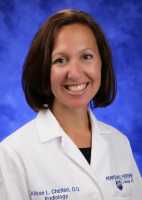21 Jul Despite Notification, Most High Risk Patients Do Not Seek Further Breast Cancer Evaluation
 MedicalResearch.com Interview with:
MedicalResearch.com Interview with:
Alison L. Chetlen, D.O.
Associate Professor, Department of Radiology
Penn State Milton S. Hershey Medical Center
Hershey, PA 17033
Medical Research: What is the background for this study?
Dr. Chetlen: Breast cancer risk assessment provides a means of identifying women who are at risk for development of this disease. Identifying individuals at high risk for breast cancer allows for genetic testing, supplemental breast cancer screening, possibly prophylactic surgery or chemoprevention in hopes of decreasing mortality from breast cancer. Despite the advantages of cancer genetic risk assessment and testing, most individuals in the general population who would benefit from such services currently do not receive them.
Medical Research: What are the main findings?
Dr. Chetlen: After implementation of a specific high-risk recommendation within our standardized mammography report along with a letter written in “lay” language informing patients of their high-risk status, the number of referrals to our high-risk clinic increased only modestly. Despite these specific recommendations to both physicians and patients, over 85% of high risk patients did not consult a high-risk provider regarding their elevated lifetime risk of breast cancer.
Medical Research: What should clinicians and patients take away from your report?
Dr. Chetlen: Patients should understand the significance of an increased familial cancer risk to increase the likelihood that they will follow through on consulting such a provider. Recognition of high risk by primary care providers and communication of this risk to patients is not currently optimized. Increased collaboration between primary care physicians and breast radiologists through educational programs and community outreach programs may allow for improved care of the population of women at high risk for breast cancer.
Medical Research: What recommendations do you have for future research as a result of this study?
Dr. Chetlen: The process of risk assessment and referral, evaluation by genetic counselors, genetic testing, and use of intensive screening is clearly complex and must include shared decision making with patients. Further research is needed to determine the effects of enhanced education for referring providers and for patients, in addition to the mammogram letter, to ensure that patients at high risk for breast cancer receive adequate personal counseling, supplemental screening, and preventive therapies.
Citation:
Journal of the American College of Radiology
DOI: http://dx.doi.org/10.1016/j.jacr.2015.04.024
Published Online: July 14, 2015
[wysija_form id=”3″]
Alison L. Chetlen, D.O. (2015). Despite Notification, Most High Risk Patients Do Not Seek Further Breast Cancer Evaluation
Last Updated on July 21, 2015 by Marie Benz MD FAAD
